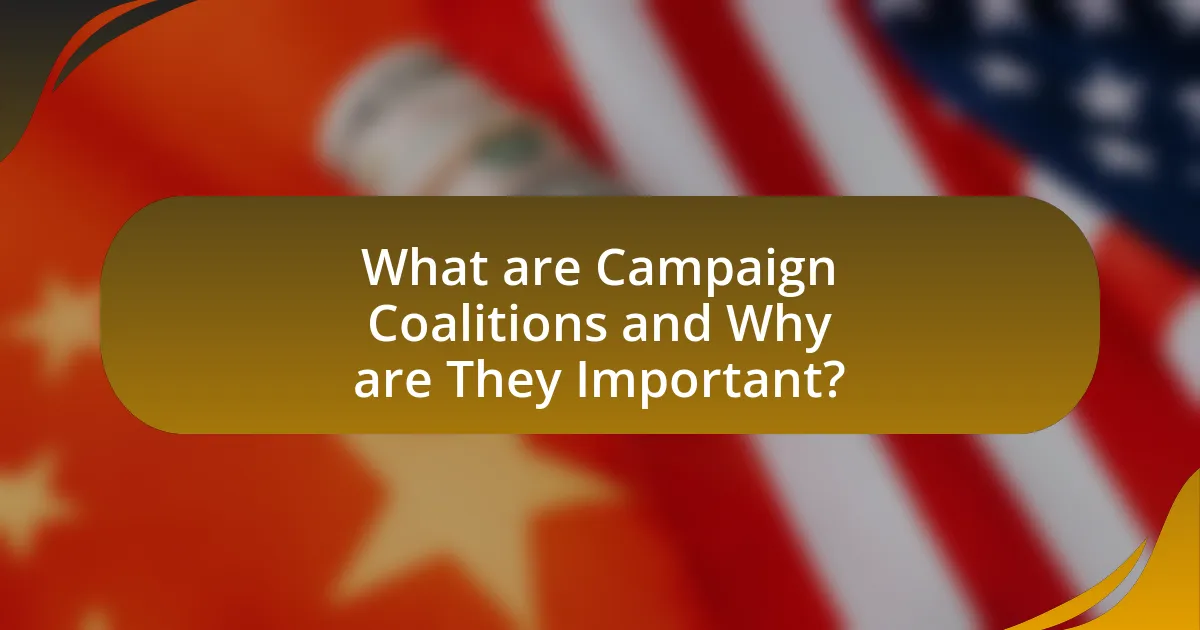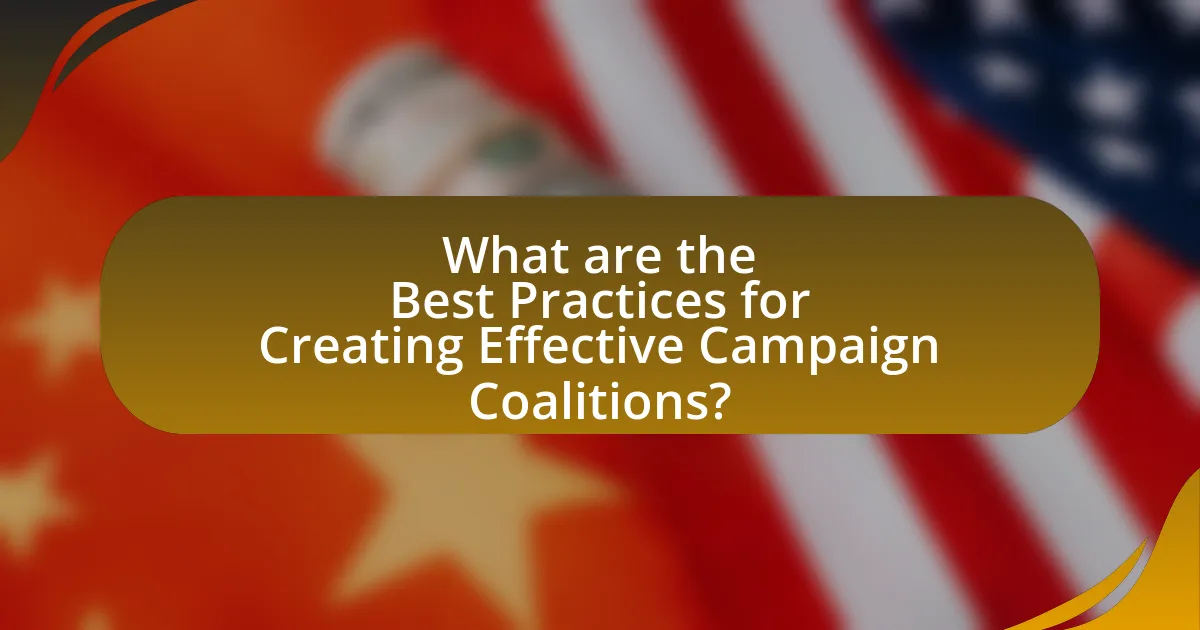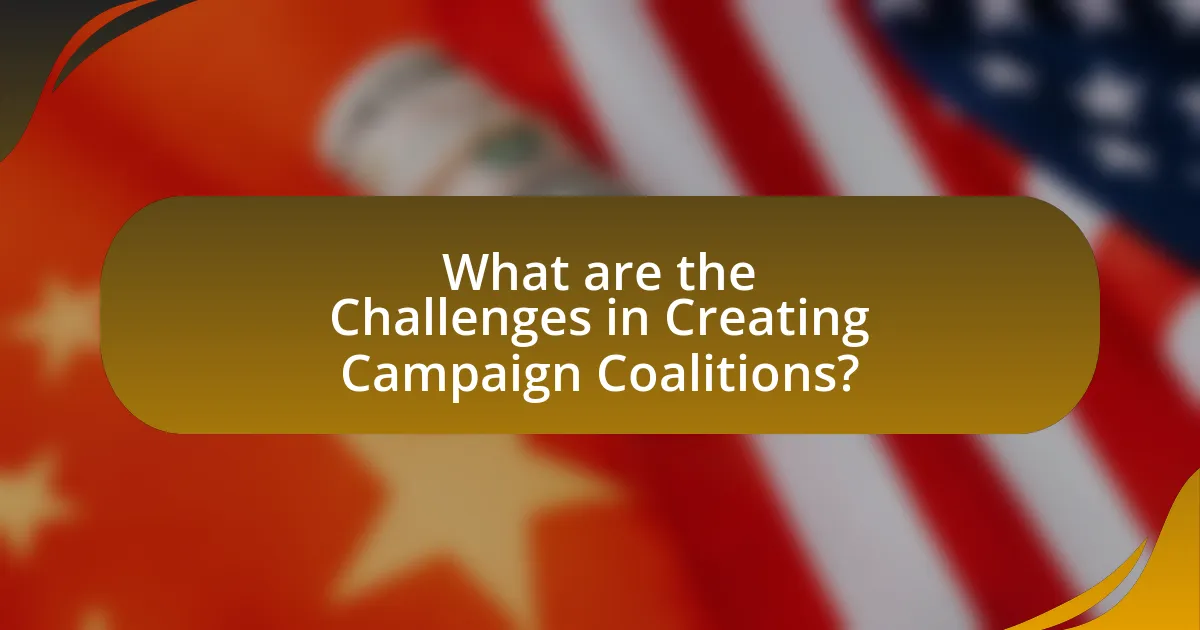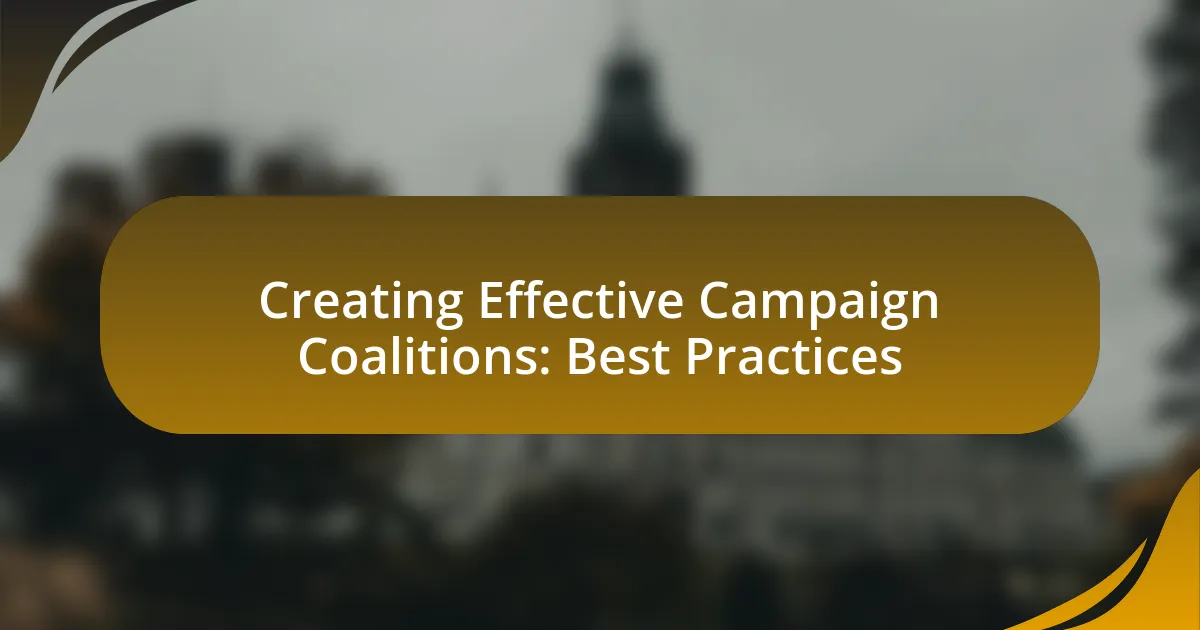Campaign coalitions are strategic alliances formed among organizations, groups, or individuals to achieve shared political or social objectives. This article outlines the significance of campaign coalitions, detailing their functions across various contexts, the roles of different stakeholders, and the characteristics that contribute to their effectiveness. It also addresses best practices for creating successful coalitions, including establishing clear goals, fostering open communication, and ensuring diverse representation. Additionally, the article explores challenges faced during coalition formation, strategies for building trust, and methods for securing ongoing funding and resources, ultimately emphasizing the importance of leadership and adaptability in sustaining coalition efforts.

What are Campaign Coalitions and Why are They Important?
Campaign coalitions are alliances formed between various organizations, groups, or individuals to achieve a common goal, particularly in political or social campaigns. These coalitions are important because they enhance resource sharing, increase influence, and amplify the voices of the participating entities, leading to more effective advocacy and mobilization efforts. For instance, research shows that coalitions can significantly improve campaign outcomes by pooling expertise and expanding outreach, as evidenced by successful movements like the Civil Rights Movement, where diverse groups united to push for legislative change.
How do Campaign Coalitions function in various contexts?
Campaign coalitions function by uniting diverse stakeholders to achieve common goals, leveraging their collective resources and influence. In political contexts, these coalitions often bring together various interest groups, parties, and organizations to amplify their voices and increase their chances of success in elections or policy advocacy. For instance, during the 2020 U.S. presidential election, coalitions formed among environmental, labor, and civil rights organizations to support candidates who prioritized progressive policies, demonstrating the effectiveness of collaboration in mobilizing voter support. In social movements, such as the Women’s March, coalitions unite different demographics and ideologies to advocate for gender equality, showcasing how shared objectives can transcend individual differences. These examples illustrate that campaign coalitions are essential for maximizing impact across various contexts by pooling resources, expertise, and networks.
What roles do different stakeholders play in a Campaign Coalition?
In a Campaign Coalition, different stakeholders play crucial roles that contribute to the coalition’s effectiveness. For instance, advocacy organizations often lead the coalition by setting strategic goals and mobilizing resources, while community groups provide grassroots support and local insights that enhance outreach efforts. Funders, such as foundations or government entities, supply financial resources and may influence the coalition’s priorities based on their interests. Additionally, policymakers engage with coalitions to understand public sentiment and may use coalition findings to inform legislation. Research indicates that successful coalitions leverage the unique strengths of each stakeholder, fostering collaboration that amplifies their collective impact on policy change.
How do Campaign Coalitions enhance collective impact?
Campaign coalitions enhance collective impact by uniting diverse stakeholders to address complex social issues collaboratively. This collaboration allows for pooling of resources, sharing of expertise, and alignment of strategies, which increases the overall effectiveness of initiatives. For instance, research by the Collective Impact Forum indicates that coalitions can lead to improved outcomes by fostering shared goals and accountability among partners, ultimately resulting in more sustainable change in communities.
What are the key characteristics of effective Campaign Coalitions?
Effective campaign coalitions are characterized by shared goals, strong leadership, diverse membership, effective communication, and strategic planning. Shared goals ensure that all members are aligned in their objectives, which fosters unity and purpose. Strong leadership is essential for guiding the coalition, making decisions, and motivating members. Diverse membership brings various perspectives and resources, enhancing creativity and problem-solving capabilities. Effective communication facilitates collaboration and ensures that all members are informed and engaged. Strategic planning allows coalitions to set clear objectives, allocate resources efficiently, and measure progress, which is crucial for achieving desired outcomes. These characteristics collectively contribute to the success and sustainability of campaign coalitions.
How does shared vision contribute to coalition effectiveness?
Shared vision significantly enhances coalition effectiveness by aligning the goals and motivations of diverse stakeholders. When coalition members share a common vision, it fosters collaboration, improves communication, and increases commitment to collective objectives. Research indicates that coalitions with a shared vision are more likely to achieve their goals, as evidenced by a study published in the Journal of Community Psychology, which found that shared vision among coalition members led to a 30% increase in successful project outcomes. This alignment not only streamlines decision-making processes but also cultivates a sense of ownership and accountability among participants, ultimately driving the coalition toward greater impact and sustainability.
What communication strategies are essential for successful coalitions?
Effective communication strategies essential for successful coalitions include establishing clear messaging, fostering open dialogue, and utilizing diverse communication channels. Clear messaging ensures that all coalition members understand the coalition’s goals and objectives, which is critical for alignment and collaboration. Open dialogue encourages transparency and trust among members, facilitating problem-solving and decision-making. Utilizing diverse communication channels, such as meetings, emails, and social media, allows for broader engagement and ensures that all voices are heard, which is vital for inclusivity and effectiveness in coalition efforts.

What are the Best Practices for Creating Effective Campaign Coalitions?
The best practices for creating effective campaign coalitions include establishing clear goals, fostering open communication, and ensuring diverse representation. Clear goals align coalition members on shared objectives, enhancing focus and collaboration. Open communication builds trust and facilitates problem-solving, while diverse representation brings varied perspectives, enriching the coalition’s strategies. Research indicates that coalitions with defined goals and strong communication are 30% more likely to achieve their objectives, demonstrating the importance of these practices in successful coalition-building.
How can organizations identify potential coalition partners?
Organizations can identify potential coalition partners by conducting a thorough stakeholder analysis to assess shared goals and values. This process involves mapping out organizations within the relevant sector, evaluating their missions, and determining their alignment with the organization’s objectives. For instance, a study by the National Council of Nonprofits highlights that successful coalitions often emerge from partnerships where entities share similar missions and target demographics, enhancing collaboration effectiveness. Additionally, leveraging networking events and industry conferences can facilitate connections with like-minded organizations, further aiding in the identification of potential partners.
What criteria should be used to evaluate potential partners?
To evaluate potential partners, organizations should consider alignment of goals, resources, expertise, and reputation. Alignment of goals ensures that all partners share a common vision and objectives, which is crucial for effective collaboration. Resources refer to the financial, human, and technological assets that each partner can contribute, impacting the coalition’s overall capacity. Expertise involves assessing the skills and knowledge each partner brings, which can enhance the coalition’s effectiveness. Reputation is important as it reflects the partner’s credibility and trustworthiness, influencing stakeholder perceptions and support. These criteria are essential for forming successful campaign coalitions, as evidenced by studies showing that partnerships with aligned goals and complementary resources lead to higher success rates in collaborative initiatives.
How can organizations approach potential partners for collaboration?
Organizations can approach potential partners for collaboration by clearly defining mutual goals and demonstrating the value of partnership. Establishing a shared vision helps align interests and fosters trust, which is crucial for successful collaboration. Research indicates that organizations that articulate specific benefits, such as resource sharing or enhanced reach, are more likely to attract partners. For instance, a study by the Stanford Social Innovation Review highlights that partnerships with clear, mutual benefits can lead to increased innovation and effectiveness in campaigns.
What strategies can be employed to build trust within a coalition?
To build trust within a coalition, transparent communication is essential. Regularly sharing information, updates, and decision-making processes fosters an environment of openness, which is critical for trust. Research indicates that coalitions with high levels of transparency experience increased collaboration and commitment among members, as evidenced by a study published in the Journal of Community Psychology, which found that transparency significantly correlates with trust levels in collaborative efforts. Additionally, establishing shared goals and values aligns the coalition members, reinforcing trust through a common purpose.
How does transparency influence trust-building in coalitions?
Transparency significantly enhances trust-building in coalitions by fostering open communication and accountability among members. When coalition partners share information openly, it reduces uncertainty and suspicion, allowing members to align their goals and expectations. Research indicates that transparency leads to higher levels of trust, as evidenced by a study published in the Journal of Business Ethics, which found that organizations with transparent practices experienced increased trust among stakeholders. This trust is crucial for collaboration, as it encourages members to engage more fully and commit to shared objectives, ultimately strengthening the coalition’s effectiveness.
What role does conflict resolution play in maintaining coalition integrity?
Conflict resolution is essential for maintaining coalition integrity as it addresses and mitigates disputes that can undermine collaboration. Effective conflict resolution fosters open communication, builds trust among coalition members, and ensures that differing perspectives are acknowledged and reconciled. Research indicates that coalitions with strong conflict resolution mechanisms are more likely to achieve their goals and sustain member engagement, as evidenced by studies showing that organizations with established conflict management strategies report higher satisfaction and commitment levels among participants.

What are the Challenges in Creating Campaign Coalitions?
Creating campaign coalitions faces several challenges, including differing priorities among stakeholders, communication barriers, and resource allocation issues. Differing priorities can lead to conflicts in objectives, making it difficult to align efforts towards a common goal. Communication barriers often arise from varying organizational cultures and terminologies, which can hinder collaboration and understanding. Additionally, resource allocation issues, such as funding and manpower, can create disparities in commitment and participation levels among coalition members. These challenges can significantly impact the effectiveness and sustainability of campaign coalitions.
What common obstacles do coalitions face during formation?
Coalitions commonly face obstacles such as differing priorities among members, lack of trust, and resource constraints during formation. Differing priorities can lead to conflicts over goals and strategies, making it challenging to establish a unified direction. Lack of trust among potential coalition members can hinder collaboration and open communication, which are essential for effective teamwork. Resource constraints, including limited funding and personnel, can restrict the coalition’s ability to mobilize effectively and achieve its objectives. These obstacles are frequently documented in studies on coalition dynamics, highlighting the importance of addressing them to foster successful partnerships.
How can differing agendas impact coalition dynamics?
Differing agendas can significantly impact coalition dynamics by creating tension and conflict among members. When coalition partners have divergent goals or priorities, it can lead to misunderstandings, reduced collaboration, and ultimately, the failure to achieve collective objectives. For instance, a study by the National Democratic Institute found that coalitions with aligned agendas were 30% more likely to succeed in their initiatives compared to those with conflicting interests. This evidence illustrates that shared goals are crucial for maintaining unity and effectiveness within a coalition.
What strategies can mitigate the effects of resource disparities?
Strategies that can mitigate the effects of resource disparities include equitable resource allocation, community engagement, and capacity building. Equitable resource allocation ensures that resources are distributed based on need rather than availability, which can be supported by data-driven assessments of community needs. Community engagement fosters collaboration among stakeholders, allowing for shared resources and knowledge, as evidenced by successful initiatives like the Community Development Block Grant program, which emphasizes local input in resource distribution. Capacity building enhances the skills and abilities of under-resourced groups, enabling them to effectively utilize available resources, as demonstrated by programs that provide training and support to grassroots organizations. These strategies collectively address the root causes of resource disparities and promote more equitable outcomes.
How can coalitions adapt to changing circumstances?
Coalitions can adapt to changing circumstances by implementing flexible strategies and maintaining open communication among members. This adaptability allows coalitions to respond effectively to new challenges, such as shifts in public opinion or policy changes. For instance, during the COVID-19 pandemic, many advocacy coalitions adjusted their messaging and outreach methods to address emerging health concerns and engage with their audiences virtually. Research shows that coalitions that prioritize adaptability and responsiveness are more likely to achieve their goals, as they can pivot quickly in response to external pressures or opportunities.
What processes can be implemented for ongoing evaluation and adaptation?
Ongoing evaluation and adaptation can be implemented through continuous feedback loops, regular performance assessments, and data-driven decision-making. Continuous feedback loops involve gathering input from coalition members and stakeholders to identify areas for improvement, ensuring that the coalition remains responsive to changing needs. Regular performance assessments, such as quarterly reviews, allow coalitions to measure progress against established goals and objectives, facilitating timely adjustments. Data-driven decision-making relies on analyzing relevant metrics and outcomes to inform strategies, ensuring that adaptations are based on concrete evidence rather than assumptions. These processes collectively enhance the coalition’s effectiveness and adaptability in achieving its campaign objectives.
How can coalitions remain flexible while maintaining focus on goals?
Coalitions can remain flexible while maintaining focus on goals by establishing clear objectives and regularly reviewing progress. This approach allows coalitions to adapt strategies in response to changing circumstances without losing sight of their primary aims. For instance, a study by the National Coalition for Dialogue & Deliberation highlights that coalitions that implement adaptive management practices can pivot effectively while still achieving their intended outcomes. Regular communication and feedback loops among coalition members further enhance this flexibility, ensuring that all participants are aligned and can respond to new challenges or opportunities as they arise.
What are the practical steps to ensure coalition sustainability?
To ensure coalition sustainability, establish clear goals and a shared vision among all members. This alignment fosters commitment and direction, which are essential for long-term collaboration. Regular communication and engagement among coalition members strengthen relationships and facilitate problem-solving. Additionally, securing diverse funding sources enhances financial stability, allowing the coalition to maintain operations and initiatives. Implementing evaluation mechanisms to assess progress and adapt strategies ensures that the coalition remains relevant and effective over time. Research indicates that coalitions with strong leadership and defined roles are more likely to sustain their efforts, as seen in studies by the Community Tool Box, which highlight the importance of structured governance in coalition success.
How can coalitions secure ongoing funding and resources?
Coalitions can secure ongoing funding and resources by establishing strong relationships with diverse funding sources, including government grants, private foundations, and corporate sponsorships. These relationships can be strengthened through consistent communication, demonstrating impact through data and success stories, and aligning coalition goals with the funders’ missions. For instance, coalitions that effectively showcase their outcomes, such as increased community engagement or policy changes, are more likely to attract repeat funding. Additionally, diversifying funding streams reduces dependency on a single source, enhancing financial stability. Research indicates that coalitions with a strategic funding plan and clear accountability measures are more successful in maintaining long-term financial support.
What role does leadership play in sustaining coalition efforts?
Leadership is crucial in sustaining coalition efforts as it provides direction, fosters collaboration, and maintains motivation among diverse stakeholders. Effective leaders establish a shared vision and clear goals, which align the coalition’s members towards common objectives. For instance, research by the National Council of Nonprofits highlights that strong leadership enhances communication and trust, essential for coalition longevity. Additionally, leaders facilitate conflict resolution and encourage participation, ensuring that all voices are heard and valued, which is vital for maintaining engagement and commitment over time.
What are the key takeaways for creating effective Campaign Coalitions?
Key takeaways for creating effective Campaign Coalitions include establishing clear goals, fostering open communication, and ensuring diverse representation. Clear goals align coalition members towards a common purpose, enhancing focus and effectiveness. Open communication facilitates trust and collaboration, allowing for the sharing of ideas and resources. Diverse representation brings varied perspectives, which can lead to more innovative solutions and broader community support. Research indicates that coalitions with these characteristics are more likely to achieve their objectives and sustain long-term impact.
